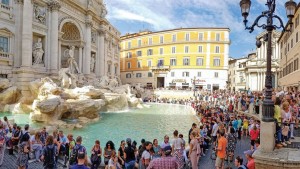
Overtourism is now becoming a critical issue with thousands of people traveling to famous holiday destinations. From a young age, people have been hearing about these remarkable places people go to, the awesome sites and sceneries in different areas and have aspired to see them one day. This avalanche of tourists has raised many concerns that even governments have to intervene.
The Oxford English Dictionary has recently added the word “Overtourism” to their glossary. According to the dictionary, it is defined as an excessive number of visitors heading to a famous location, damaging the environment and having a detrimental impact on the resident’s lives.
Overtourism is caused by various factors which, when dealt with, can help in curbing this problem. The most common factor is cheap traveling means to the places. During holidays, you will get airlines offering cheap flights putting in mind that these planes can carry many people. In addition, the reduction of fuel cost during holidays is another factor that fuels overtourism among the increase in income and paid summer vacations.
Another key factor that has contributed to mass tourism is the emergence of travel packages. Traveling agencies offer these packages having subsidized the tours. The packages also include transportation, accommodation, food, and activities: making it more comfortable for one to go on a vacation. These packages started to be produced in masses, and that is where everything went south.
As much as tourism can and has already affected many cities positively, too much of it is doing more harm than good. Most of these cities are experiencing an identity crisis: they have become more reliant of tourist to a point where even their way of living, economy, and activities are dictated by the tourists going to the places. Other signs of toxicity of overtourism are degradation of the environment, heavy traffic on the roads and high rents, which locals cannot afford among others. If overtourism is not taken care of, it will make the place to lose its authenticity as a tourists destination and also, the locals will eventually be annoyed and irritated.
To clearly understand how harmful overtourism can be, we will have a more in-depth look at the detrimental effects it has on the destinations.
1) Environmental effects.
The quality of the environment as far as tourism is concerned is an important factor. If it is not beautiful, then the tourist will not visit the place. This necessitates more care and maintenance.
However, overtourism has proven to be harmful to the environment; it is polluted by poor disposal of waste. As tourist travel from one place to another, they buy things and end up littering the site they visit. Besides that, too many tourists can pollute the air, water, and soil as they travel using cars and ships. While visiting the zoos and game parks, they may destroy plants and interfere with the animal’s habitats. Also, infrastructure that is not designed to handle a lot of people may end up being destroyed by many tourists. The negative impact on the environment is enormous.
2) Social effect.
Social effects mostly affect the local community in the area. The quality of their life drastically changes as controlled by the unending tourist activities in the region. As the tourist and hosts interact, they exchange a lot of life’s aspects like culture, linguistics and also currency. Tourism helps in bridging the gap between them, but it will eventually affect both parties in the end. With continuous visits to the places, the hosts will ultimately lose their way of life because of integrating the many cultures gotten from the tourists.
In some places, the locals are becoming extinct as tourists are outnumbering them. For instance, in Venice, the number of residents is half as it was 30 years back. Approximately 1000 resident leave the city annually: if this continues, it is possible to have no permanent resident in Venice by 2030. Dubrovnik in Croatia is facing a similar challenge: it has only 1000 resident compared to five years ago when the residents were more than 5000. It receives approximately 15,000 tourists in a day with one time having 1.7 million tourists in 7 months.
Fortunately, the government and tour operators in the various destinations are tackling the issue.
“Tourism is like any other industry: it needs to be regulated and managed locally to prevent negative impacts,” says Justin Francis, the CEO Responsible Travel: a UK based tour operator.
Various strategies have been put in place to ensure the locals’ needs are met first. For instance, the ticketing system is being used in popular destinations such as in the ruins of 15th century Inca citadel in Machu Picchu, Peru. These tickets are time-bound: the slots last for only four hours, and re-entry is not allowed.
Other places like The Dutch capital, Amsterdam, are working on ‘destination management’ instead of ‘destination promotion.’ By this, tourists’ attention is being diverted from the town to other cities in the country. Dubrovnik, Croatia has also put some limits on the number of people visiting places and the number of passenger ships visiting its ancient walls.
All these restrictions are working well for the respective destinations in curbing overtourism. However, there is a price to pay: the revenue that the tourists were bringing might drop.

Leave A Comment